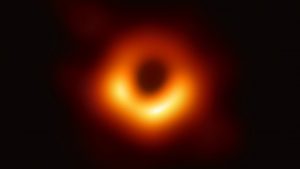KECTIL CONGRATULATES DR. KATIE BOUMAN
We now have proof that youth can do anything they set their minds to!! A 29 year old female, Katie Bouman, is credited with creating the mathematical algorithm that allowed astrophysicists to get the first picture of a black hole!!
What is a Black Hole?
A black hole is a great amount of dense matter in a very small space due to a gravitational field that is so strong that not even light can escape. Black holes were predicted by Einstein’s Theory of Relativity, which showed that when a huge star dies, it leaves behind a small dense core. If the core is at least 3 or more times the size of the sun, the force of gravity overwhelms all other forces, preventing anything from escaping and swallowing things around it. Things that fall into it get pulled like spaghetti! Kind of scary!
Why was a picture so important?
Even though scientists know black holes exist, they had never seen one!
When did scientists get the first picture of a black hole?
This week! It is breaking news!
What does the picture show?
It is a dark spot with a red glowing circle around it. It is 55 million light-years away (thank goodness!). The dark spot is a sink, or an exit portal from our observable universe. We can’t see what is on the other side because light can’t travel out. The red ring is about 2.5 times bigger than the hole itself. The ring is red and bright because matter is being torn to smithereens at temperatures of billions of degrees as it gets devoured by the black hole. So, you can say goodbye to anything in the picture that is red! And new matter will replace it as it gets swallowed.
How did scientists get the picture?
The scientific team created a huge virtual telescope the size of the earth by connecting observatories in different places in the world include United States, Germany, Greenland, Chili, South Pole, Spain, the Antarctic ice sheetand Mexico.
How did a Youth make the project a success?
To make sense of the data coming in, the team needed complex algorithms that could distill all the noisy, messy information into one comprehensible picture. A 29 year old female, Katie Bouman, whose expertise is not in astrophysics but computer science, was one of a small group of people who spent years developing and testing those methods.
“We all watched as the images appeared on our computers. The ring came so easily. It was unbelievable,” Katie Bouman told Time magazine. The world saw that ring – a swirl of light and substance revealing the shadow of an unseeable mass yesterday, when a team of more than 200 researchers presented a picture of the black hole lying at the center of the Messier 87 (M87) galaxy. While Katie’s work was crucial to the project, she sees her real contribution as thinking in a new way. “What I did was brought the culture of testing ourselves,” she says.
Katie is currently a postdoctoral fellow with the Event Horizon Telescope and will be an Assistant Professor in the CMS department at Caltech in 2019. The focus of her research is on using emerging computational methods to push the boundaries of interdisciplinary imaging.
Dr Bouman says that most of the time she’s not focused on the fact that she’s in a field where women are the minority. “But I do sometimes think about it. How do we get more women involved?” she says. “One key is showing that when you go into fields like computer science and engineering, it’s not just sitting in a lab putting together a circuit or typing on your computer.”
At twenty-nine years old Dr Bouman has already written history. The Kectil Program congratulates her on this huge achievement. Albert Einstein would be proud.

